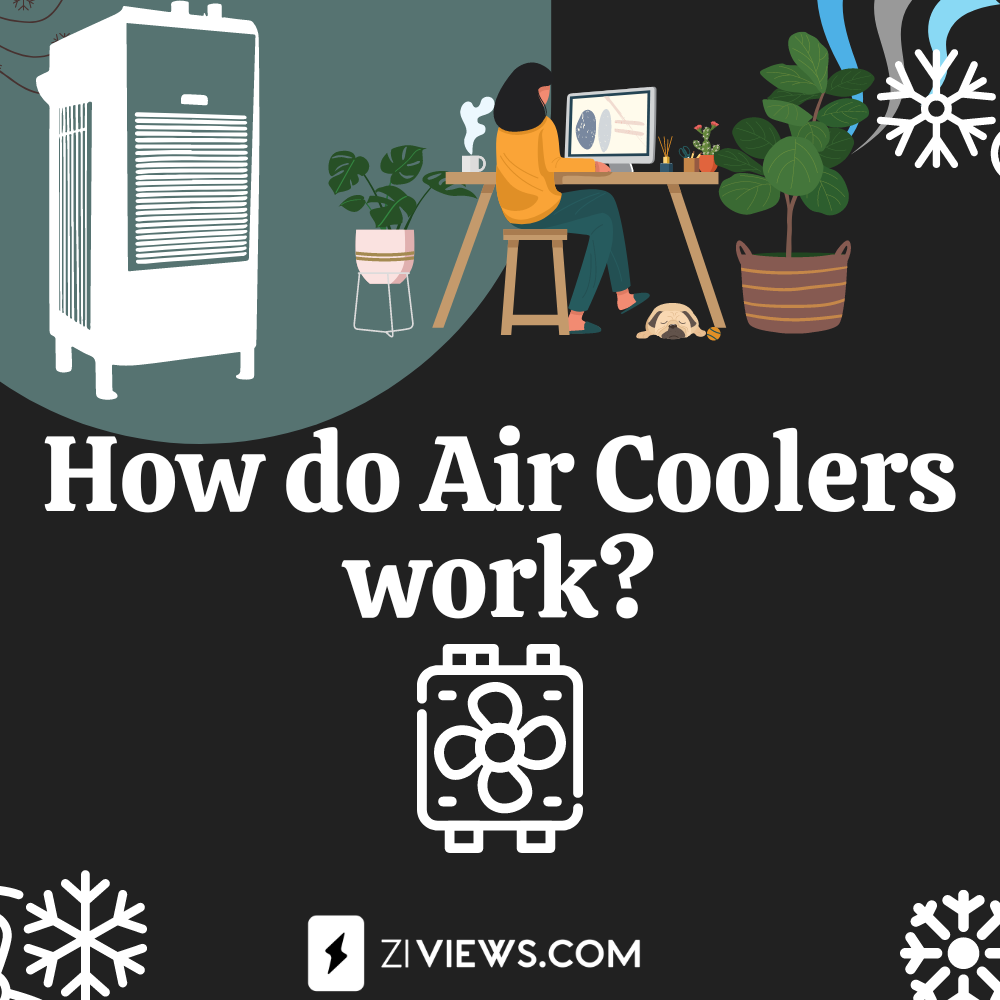In the quest for eco-friendly and cost-effective alternatives to traditional air conditioning, air coolers have emerged as a popular choice across India.
Leveraging the natural process of water evaporation, these devices offer an efficient way to cool spaces while minimizing environmental impact and energy costs.

This guide delves into the science of how air coolers work (through evaporative cooling) the critical role of ventilation, and the mechanics behind air coolers’ operational efficiency.
The Science of Evaporative Cooling Explained
Evaporative cooling stands as a testament to nature’s inherent simplicity and efficiency. At its core, this process involves water absorbing heat from the surrounding air as it evaporates, leading to a reduction in air temperature.

This principle, fundamental to air coolers, harnesses the cooling effects of water vaporization to enhance indoor climate control.
Key Components of Air Coolers
An understanding of air cooler technology begins with its four main components:
Cooling Pads: Serve as the medium through which water evaporates, absorbing heat from the air.

Water Tank: Supplies water to the cooling pads.

Pump: Ensures the even distribution of water over the cooling pads.

Fan: Draws in hot air to pass through wet cooling pads, then circulates cooled air into the room.

Each component plays a pivotal role in the air cooler’s functionality, contributing to its overall efficiency and effectiveness in cooling.
Tower Air Coolers Working Process
Design and Use: Tower air coolers are designed for compact spaces, known for their tall, slender build which makes them ideal for small rooms or areas where floor space is limited. They often feature powerful fans or blowers that distribute air vertically.
Working Process:
- Water Distribution: Tower coolers use a pump to distribute water to a specially designed cooling media at the sides of the tower.
- Air Intake and Cooling: The fan at the top draws warm air from the room through the moist cooling media. As the air passes through, water evaporates, cooling and humidifying the air.
- Air Output: The cooler then releases the cooled air upward, creating a refreshing vertical airflow that cools the environment efficiently.
Personal Air Coolers Working Process
Design and Use: Personal air coolers are smaller, portable units designed for individual use. They are perfect for single users in small spaces like work desks or bedside tables.
Working Process:
- Simple Water Tank: Users fill the tank with water; some models also allow for ice packs or cold water for additional cooling.
- Direct Air Cooling: The air is drawn in, passed over the wet cooling media where it is cooled by evaporation, and then directed straight towards the user.
- Customized Cooling: These coolers usually offer adjustable settings to control airflow and cooling levels, making them highly personalized.
Desert Air Coolers Working Process
Design and Use: Desert air coolers are designed for dry, arid climates and are capable of cooling larger spaces such as halls or outdoor areas. They have large water tanks and powerful fans to cover more area.
Working Process:
- Large Water Capacity: The substantial tank provides continuous water flow to thick cooling pads, ideal for prolonged cooling periods.
- Effective in Dry Heat: The fan pulls hot, dry air through these pads, facilitating more evaporation and therefore more cooling, which is especially effective in desert-like conditions.
- Widespread Cooling: Thanks to their powerful fans, desert coolers can push cooled air over long distances, making them suitable for large rooms or outdoor spaces.
Commonalities and Ventilation
While the design and use-case vary, the fundamental principle of evaporative cooling underpins all types of air coolers. Regardless of the model, maintaining good ventilation in the room is crucial.
It ensures a continuous supply of dry air, enhancing the cooler’s efficiency and preventing humidity build-up.
Understanding the Importance of Ventilation
Ventilation is crucial in maximizing the efficiency of air coolers. It facilitates the continuous flow of fresh air, allowing saturated air (rich in humidity) to be replaced by dryer, warmer air, which is then cooled through evaporation.
Proper ventilation ensures that humidity does not build up inside the room, maintaining the cooler’s effectiveness.
The Efficiency of Air Coolers in India’s Climate
India’s predominantly hot and dry climate, especially in the northern and central regions, creates the perfect environment for air coolers to excel.
In these conditions, evaporative cooling can significantly reduce indoor temperatures, offering a refreshing respite from the heat without the high energy costs associated with air conditioners.
Maintaining Your Air Cooler for Optimal Performance
Regular maintenance is key to sustaining the efficiency of your air cooler. Simple steps include:
- Cleaning the cooling pads and water tank to prevent mold and mineral buildup.
- Ensuring the pump is functioning correctly to distribute water evenly.
- Checking the fan for optimal performance.
These practices not only extend the life of the air cooler but also enhance its cooling efficiency.
Advantages of Choosing an Air Cooler Over Traditional AC
Opting for an air cooler comes with several benefits:
- Environmental Impact: Air coolers use water as a cooling medium, avoiding the harmful refrigerants found in AC systems.
- Energy Efficiency: They consume significantly less electricity, contributing to lower energy bills.
- Cost-Effectiveness: With lower initial investment and maintenance costs, air coolers are an economical cooling solution.
- Portability: Many models are designed for easy movement, allowing you to cool different areas as needed.
Conclusion
Air coolers represent a sustainable, efficient, and economical solution for cooling homes in India’s hot climate. By understanding the technology behind evaporative cooling and adhering to best practices in maintenance and ventilation, homeowners can enjoy the benefits of this eco-friendly cooling method.
Looking for the best air cooler for your needs? Dive into our comprehensive buying guide on the Best Air Coolers in India, featuring detailed reviews and recommendations to help you make an informed decision.




